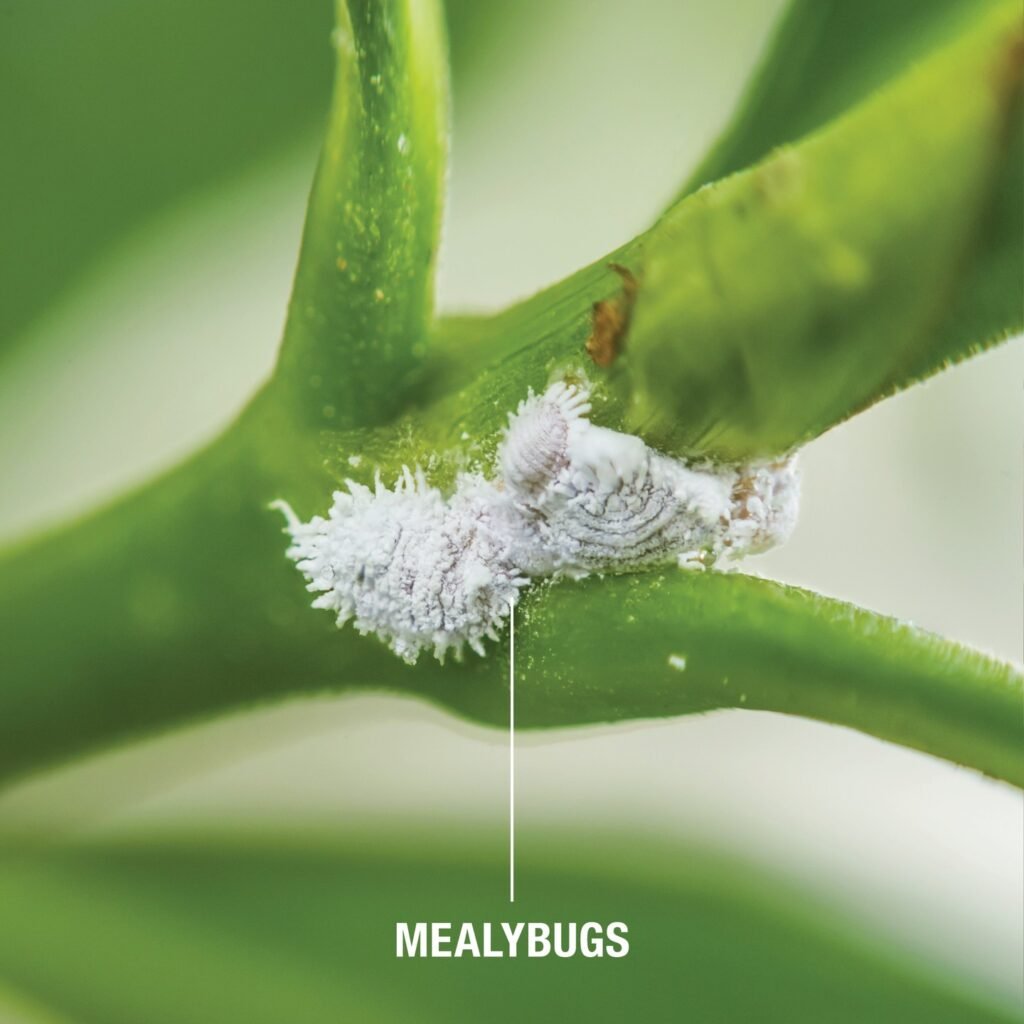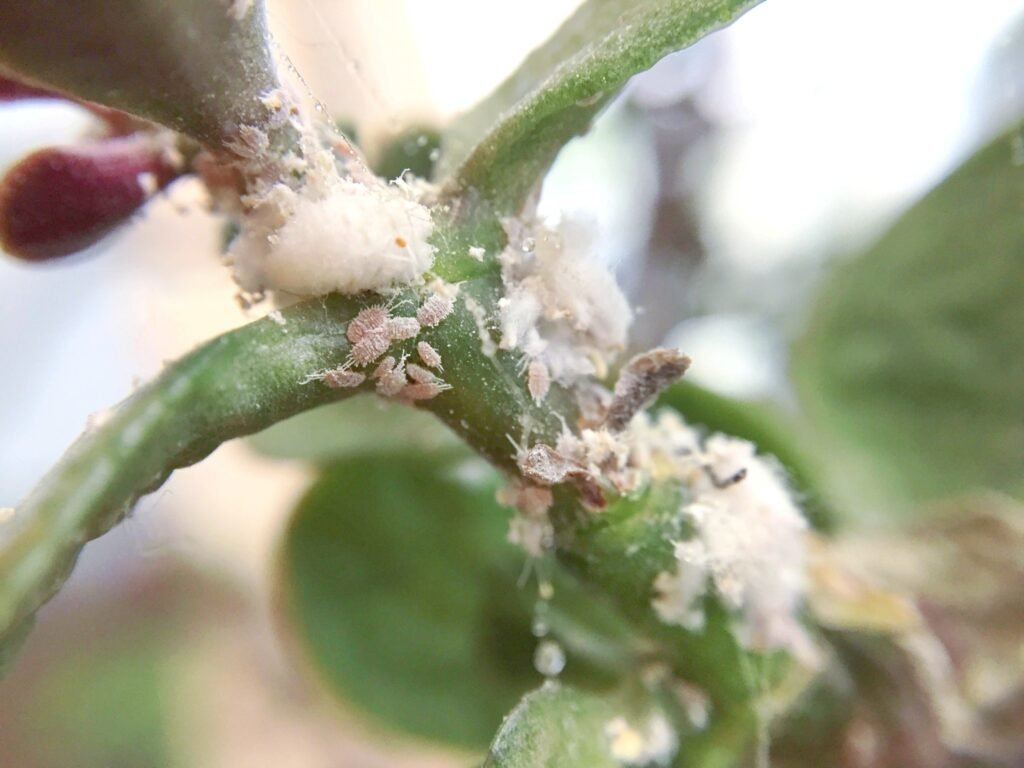Mealybugs are pesky little pests that can often be found making themselves at home on a variety of indoor and garden plants across the UK. These tiny insects, part of the larger family of scale insects, are known for their distinctive white, powdery coating, which helps them blend in with the foliage they feed upon. They’re particularly fond of warm, dry environments, making indoor plants and greenhouses their preferred habitats, though they can also venture into gardens during the warmer months between May and September.
Mealybugs are pesky little pests that can often be found making themselves at home on a variety of indoor and garden plants across the UK. These tiny insects, part of the larger family of scale insects, are known for their distinctive white, powdery coating, which helps them blend in with the foliage they feed upon. They’re particularly fond of warm, dry environments, making indoor plants and greenhouses their preferred habitats, though they can also venture into gardens during the warmer months between May and September.

Identifying Mealybugs
Adult mealybugs appear as small (about 1.5 cm long), white insects covered in a floury, waxy secretion, giving them a cottony appearance. Their larvae are oval, slightly flattened, and range in colour from white to yellowish-pink. These pests are typically found on the underside of leaves, where they feed and lay their eggs. The good news is that mealybugs are visible to the naked eye, making early detection and control a viable option for diligent gardeners.
Common Varieties in the UK
In the UK, gardeners might encounter several types of mealybugs, including the greenhouse, azalea, and citrus mealybugs. Each type has its own preferences for plant hosts but shares a similar mode of damage by sucking the sap from plants, weakening them, and sometimes spreading diseases.
Damage caused by mealybugs
If mealybugs make their way into our gardens and go unnoticed, they can completely devastate our plants. What impact do greenhouse mealybugs have? This particular pest, which predominantly targets plants grown in protected environments as well as ornamental flowers like azaleas, roses, fuchsias, and geraniums, inflicts damage on the foliage.
The initial signs of an infestation are small yellow spots on the leaves. As the situation progresses, the leaves will turn yellow, dry out, and eventually drop off. If the infestation has reached the point where adult mealybugs are present, you’ll notice white flies dispersing from the plant with a slight shake. Alongside the presence of greenhouse mealybugs, plants may also suffer from a fungal disease, which thrives on the honeydew these pests produce.
One clear indicator of a mealybug presence is punctures on the leaves. By holding the leaves up to the light, you’ll be able to spot tiny, nibbled holes and the pests themselves residing on the plant.
This easy-to-spot sign can help even novice gardeners identify a potential mealybug problem early on.
Treatment and Prevention of mealybugs
Mealybugs are challenging pests to eliminate. The quicker we spot these unwelcome guests, the better our chances of preventing them from damaging our plants. The first step in dealing with mealybugs on ornamental plants is to gently wash the leaves. A homemade mixture of liquid soap and garlic added to water can be used to cleanse each leaf. This natural approach might not always be enough; if so, it’s wise to consider using commercial insecticides specifically designed to target mealybugs.

Home Solutions to Eliminate Mealybugs
When facing a mealybug invasion in your home or garden, there are several effective home solutions you can try to manage and eliminate these persistent pests. Here’s a straightforward guide to tackling mealybugs with items you likely already have at home:
- Isopropyl Alcohol: Apply a small amount of isopropyl (rubbing) alcohol directly onto the mealybugs using a cotton swab. This method is particularly effective for treating small infestations on indoor plants. The alcohol helps to break down the waxy coating of the mealybugs, effectively killing them.
- Soapy Water: Mix a teaspoon of liquid soap with a litre of water. Spray or gently wipe this solution on the affected areas of the plant. The soapy water suffocates the mealybugs by disrupting their outer layer. Be sure to use a mild, natural soap to avoid harming the plants.
- Neem Oil: Neem oil is a natural pesticide that’s safe for most plants and effective against mealybugs. Mix a few drops of neem oil with water and spray it on the infested areas. Repeat the treatment every few days until the mealybugs are gone. Neem oil not only kills mealybugs but also deters them from returning.
- Remove by Hand: For a small number of mealybugs, sometimes the best method is to remove them by hand. Using a pair of tweezers or a soft cloth, gently pick off the mealybugs from the plant. This method is immediate but can be time-consuming for larger infestations.
- Quarantine Infested Plants: To prevent the spread of mealybugs to other plants, isolate the affected plant as soon as you notice an infestation. This is crucial for indoor plants where mealybugs can easily move from one plant to another.
- Increase Humidity: Mealybugs prefer dry conditions, so increasing the humidity around your plants can help deter them. This can be particularly effective in indoor environments. Use a humidifier or mist your plants regularly to create a less hospitable environment for mealybugs.
- Encourage Natural Predators: In outdoor gardens, encourage natural predators of mealybugs, such as ladybirds, lacewings, and certain types of wasps. These beneficial insects can help control mealybug populations naturally.
By incorporating these home solutions into your plant care routine, you can effectively combat mealybug infestations and protect your plants from these harmful pests. Remember, persistence and consistency are key to getting rid of mealybugs for good.
Chemical Control of Mealybugs
When dealing with a severe mealybug infestation, sometimes the most effective course of action is to turn to chemical control. In the UK, there are several approved insecticides that can help manage and eliminate mealybugs from your plants. It’s important for new gardeners to understand that chemical treatments should be used responsibly and as a last resort, after trying less invasive methods. Here are some examples of chemical solutions available in the UK and tips on how to use them:
- Insecticidal Soaps: These are mild insecticides that can be very effective against mealybugs. Products like Bug Clear Ultra are popular choices. They work by breaking down the protective waxy layer of mealybugs, leading to dehydration and death of the pest. It’s important to apply these products directly to the mealybugs and repeat the application according to the product instructions for the best results.
- Systemic Insecticides: Systemic insecticides, such as Provado Ultimate Bug Killer, are absorbed by the plant and can control mealybugs feeding on it from the inside. These are particularly useful for treating large or hard-to-reach infestations. Carefully follow the label instructions for safe and effective use.
- Neem Oil-Based Products: While neem oil is often used as a natural remedy, there are also stronger, neem oil-based chemical formulations available that can act as effective insecticides against mealybugs. Products containing neem oil work by inhibiting the feeding, growth, and reproduction of pests.
- Pyrethrin-Based Insecticides: Derived from the chrysanthemum flower, pyrethrins are natural insecticides that can also be used in more concentrated forms to combat mealybugs. Products like Py Bug Killer offer a more natural chemical solution but should still be used with caution.
Tips for Using Chemical Insecticides:
- Read the Label: Always read the product label carefully before use. Pay close attention to the application instructions and safety warnings.
- Protect Yourself: Wear protective clothing, such as gloves and a mask, when applying chemical insecticides.
- Spot Treatment: If possible, apply chemical treatments to infested areas only, rather than the whole plant, to minimise harm to beneficial insects.
- Timing: Apply chemical treatments in the evening or early morning to avoid harming beneficial pollinators that are more active during the day.
- Check for Plant Sensitivity: Test the product on a small area of the plant first to ensure it does not cause damage.
Remember, while chemical control can be effective in eliminating mealybugs, it’s crucial to use these products responsibly to protect the environment and beneficial insects in your garden.





